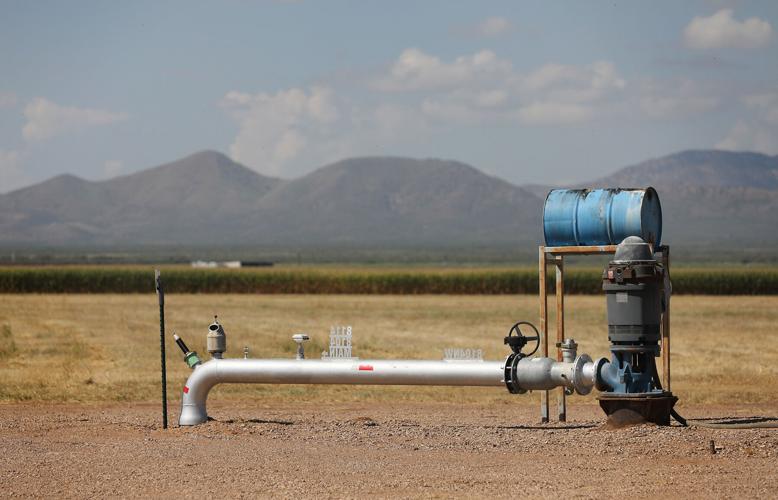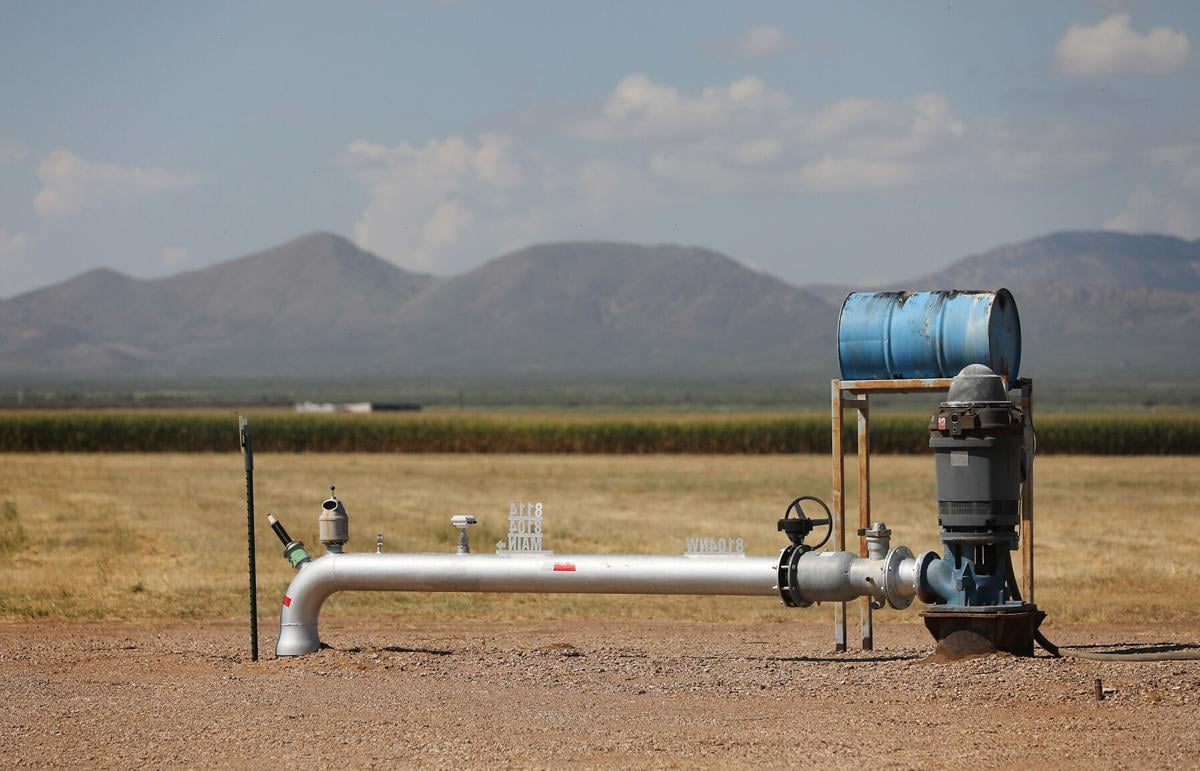As governor in 1980, Bruce Babbitt prodded southern and central Arizona farmers into accepting the first limits ever imposed on their groundwater pumping. Today, he says a different band of farmers will have to give up water again — this time by selling off their rights to it.
Babbitt helped usher in the pioneering Arizona Groundwater Management Act in 1980 after pushing the big water interest groups of the time — cities, farms and mining companies — to the table. Probably his biggest accomplishment was coaxing a very reluctant group of farmers to accept the reality that their days of runaway pumping of groundwater were done.
The law created state-regulated active management areas surrounding Tucson, Phoenix and other urban areas. In most cases, those areas were required to reach safe yield — a balance between groundwater pumping and replenishment — by 2025. For Pima, Maricopa and Pinal counties, the law also required that all new subdivisions prove they have an assured water supply for 100 years before homebuilders could start selling lots. To do that, builders must show their pumping won't lower the aquifer by more than 1,000 feet in Pima and Maricopa counties and 1,200 feet in Pinal County.
Now a former U.S. Interior secretary, Babbitt says a different group of farmers — those working along the Colorado River — must eventually accept the idea that some will have to sell out to cities to insure there's enough water left for urban growth to continue.
It's a highly controversial idea, one that rural riverfront communities have mostly staved off. But Babbitt says the need to buy and retire farms' river water rights is now "the elephant in the room," one that must be confronted even as "nobody talks about it."
The 1980 act was born of a series of crises: declining water tables in and around cities; farmers threatening water supplies of cities and mines with lawsuits; and the federal government threatening to cancel construction of the multi-billion-dollar, 336-mile-long Central Arizona Project canal if something wasn't done to upgrade the state's groundwater laws.
Today, different crises await — the threat of major cutbacks of CAP deliveries due to a drying Colorado River; state shutdowns of new homebuilding in areas where groundwater supplies are deemed inadequate; and falling water tables and drying wells in rural areas.
The Arizona Daily Star asked Babbitt how he thinks new Gov. Katie Hobbs, a fellow Democrat, and the Republican-controlled Legislature should handle this round of water woes — and whether there's much of a chance to fix them at all.
Babbitt, 84, now a private citizen, lives in Washington, D.C., while considering himself "a loyal and avid Arizonan." After exiting as governor in 1987, he served as Interior Secretary from 1993 to 2001. He has also worked as an attorney in private practice, representing a wide range of clients involved in environmental issues, and has sat on the board of the environmentalist World Wildlife Fund.

Employees with Nelson's Drilling work on drilling a new well near the Tortolita Mountains north of Tucson.
Here's what he told the Star this month in an interview:
Q. Arizona Department of Water Resources Director Tom Buschatzke was asked if this year can be a rerun of 1980. He replied: "That remains to be seen. That was a different time, with different pressures and a different Legislature. The challenge now is a diminished supply from the Colorado River. In 1980, we anticipated a new supply from the Colorado River." Could we be in for another round of groundwater law overhauls now?
A. I’m not a prophet. I just don’t know. In history, large reforms are usually triggered by some kind of crisis. The problem today centers on the Colorado River and the Central Arizona Project water supply. This crisis should motivate the Legislature to act — soon. I think the emerging issue in all of this is going to be agriculture.
Q. Why?
A. I believe there is enough water in Arizona’s Colorado River entitlement to support growth in Arizona for the next century. It's 2.8 million acre-feet. Where is that water being used today? More than a million acre-feet is being used along the river and in the Yuma area, almost all of it for agriculture. That’s where the sustainable water supply of Arizona lies. If we’re going to continue to grow in urban areas, we have to continue doing all the things we’re doing, like conservation, increased efficiency.
(But) we're going to have to come to some consensus about how a substantial portion of that river use is going to be fallowed and/or retired and brought into Central Arizona through the CAP canal. That’s the elephant in the room. And it’s a discussion that is off limits right now. Nobody talks about it. If we’re gong to continue to grow and develop, we will need a sustainable supply.
Q. Why is our growth more important than rural farming economies?
A. Approximately 75% of the water used in Arizona goes for irrigated agriculture. Agriculture generates less than 5% of Arizona GDP. That suggests the need for some rebalancing between agriculture and urban and industrial uses.
Q. Every time the idea of buying out farm water rights has been brought up, a huge protest erupts from rural residents who say it will dry up their economies, and that's usually the end of it.
A. I’m just telling you that it’s a decision that we have to make, one way or the other. We need to have a wide-ranging statewide debate about how it is we apportion the future between urban growth and agriculture.
Q. What's your reaction to Gov. Hobbs' opening water gambit — creation of a new Water Policy Council and of an Office of Resiliency to coordinate water issues, and a plan to update the 980 groundwater law to close what she called "groundwater poaching loopholes?"
A. it’s an excellent call to action and sets the stage and specifically mentions all of the important issues. The next step is making some specific proposals and getting discussion going and that will take some time.
Q. What would be your first choice for updating the groundwater law?
A. The most important one is to patch the holes in the bucket. There are still a significant number of groundwater users who have no replenishment obligations (meaning they aren't required to replenish the aquifer with as much water as they pump from it), who are just draining the groundwater. That includes mining and includes dairies.
It includes most categories of industrial users. It includes subdivisions that were in place before enactment of the groundwater law. Those need to be dealt with as a priority item.
Q. Homebuilders say the ADWR's recent decisions, closing off parts of Buckeye and Pinal County to new housing due to lack of groundwater like a big housing project proposed by the Howard Hughes Corp., will deprive people of affordable housing and raise home costs.
A. Buckeye and the Hughes development, they are complaining they can’t meet Part 1 of the assured water supply requirements: physical availability, and that’s going to prevent development.
All they have to do is develop in an area where there is a water provider where there is a designation of assured supply. There is a lot of land in the Phoenix and Tucson active management areas which is open to development. It’s not somehow cutting off our development future. All it is saying to developers is that you can’t do it where there is not a 100-year groundwater supply and the ability to carry out your legal obligation to replenish the aquifer.
What you can’t do is go out in some remote area where you can’t meet those two tests.
Q. But homebuilders say that building closer to Phoenix and Tucson will still hurt affordable housing, by increasing land buying costs and because cities have tougher regulations than unincorporated areas.
A. There are several hundred thousand acres of undeveloped land with assured water supplies within the Phoenix and Tucson active management areas. Locating development on these lands will not have a significant effect on housing costs.
Q. The governor wants to bring rural Arizona under groundwater regulations. Would you agree?
A. Of course we’ve got to deal with rural Arizona. We need a comprehensive law for rural Arizona. That does not mean simply amending the existing Groundwater Management Act, because the existing Groundwater Management Act a has a fair number of issues that may not be specifically applicable to rural Arizona.
We've really got to take a fresh start in rural Arizona. The Irrigation Non-Expansion Area (where no new irrigation is allowed) provision in the existing act is not adequate for rural areas. It can’t be invoked by petition. It’s got some ambiguity about what the criteria are for imposing an INA.
Q. Anything else that should be in new legislation to assure new development has enough water?
A. The other thing that is not specifically related to the Groundwater Management Act is reform of the Central Arizona Groundwater Replenishment District (called CAGRD for short, it's a three-county agency that buys and recharges renewable CAP water to compensate for pumping done by new homes lying outside cities with their own CAP water rights). That’s really going to be an important issue.
CAGRD isn’t going to work for large developments outside cities with state-designated assured water supplies. CAGRD, in my judgment, does not have an adequate projected future sustainable replenishment program to support the large developments. The important reform is to say, "CAGRD is not a workable supply solution for large scale developers in the Phoenix and Tucson management areas. Large scale developers must bring their own replenishment supplies to comply with safe yield goals."
Q. What could force the big water players like developers, farmers and cities to the table this time like in 1980?
A. I do think the diminishing CAP supply is going to be a forcing agent to some degree. It’s the one factor that clearly is going to get us moving toward action. As the CAP supply diminishes, it will force us to this conversation about how we are going to allocate water and where and to whom.
The Central Arizona Project is a 336-mile canal in Arizona that supplies Colorado River water for the Phoenix and Tucson area, agriculture and several Native-American tribes. Construction began in 1973 and was substantially complete by 1994. This portion is located near Sandario Road and Mile Wide Road west of Tucson on March 17, 2021. Video by: Mamta Popat / Arizona Daily Star






